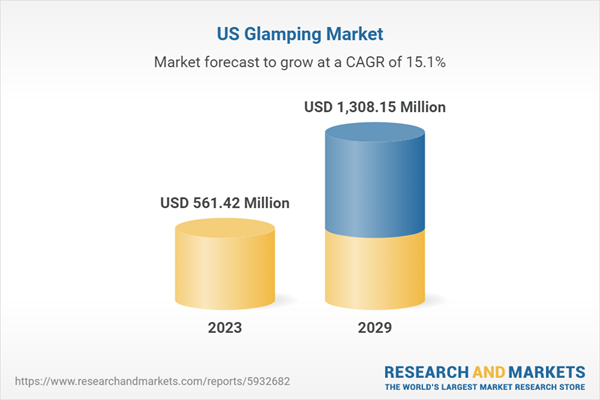Speak directly to the analyst to clarify any post sales queries you may have.
KEY HIGHLIGHTS:
- In the US, glamping has rapidly emerged as one of the fastest-growing sectors, gaining widespread recognition and acceptance among various segments of leisure travelers. During the pandemic outbreak, the travel industry came to a halt, prompting businesses to strategize on continued operations. As leisure travelers canceled trips, they sought alternative vacation planning options.
- The US is a vast country with a land area of nearly four million square miles and a population of over 338 million. It offers a variety of travel options. There is an unending list of US vacation spots, including national parks, beaches, mountains, and wilderness areas. Beach getaways in South Carolina or Big Bear Lake cabin rentals in California, skiing at ski resorts such as Aspen or Jackson Hole, or national park camping in top locations such as Acadia National Park or Yellowstone National Park are just a few of the finest glamping destinations in the US.
- Millennials and baby boomers are currently the significant generations driving the glamping niche in the US. Millennials seek trips to disconnect from technology, whereas baby boomers are drawn to outdoor and recreational activities. Many industry participants wrongly equate glamping with the millennial generation. However, baby boomers, who are nearing or have reached retirement age, should not be disregarded. Baby boomers tend to have the time and desire to travel and experiment with new housing concepts their children are also interested in.
- The growth of Airbnb also turns the pointer toward a trend where consumers require experiences that are offbeat, authentic, and approachable, breaking the traditional hotel model. Glamping is gaining popularity among retirees and those in ABC1 markets/higher social groups. In addition, the concept is expected to grow with the younger demographic, i.e., millennials entering their peak earning years and others having a higher disposable income post-recession day.
- The competition mainly revolves around innovation, services, site locations, and the comfort and convenience provided to customers. Notable players such as The Resort at Paws Up, Under Canvas, Collective Retreats, and Huttopia are leading brands contributing to the diverse and competitive landscape in the US glamping market.
LIST OF VENDORS
Key Vendors
- The Resort at Paws Up
- Under Canvas
- Collective Retreats
- Huttopia
- Tentrr
Other Prominent Vendors
- Asheville Glamping
- AutoCamp
- Capitol Reef Resort
- Camp'd Out
- Conestoga Ranch
- El Cosmico
- El Capitan Canyon
- EXP Journeys
- Fireside Resort Cabins
- Firelight Camps
- Minam River Lodge
- Nomadics Tipi Makers
- Sandy Pines Campground
- Sinya
- Ventana Big Sur
- Walden Retreats
- Bushtec Safari
- Westgate Resorts
- Mendocino Grove
- Dunton
- Backland
- Klarhet
- Bodhi Farms
- Treebones Resort
- Little Arrow Outdoor Resort
- The Mohicans
- Desolation Hotel
- West Beach Resort
- The Vintages
- Johnny Morris Nature Resorts
- Timberline Glamping
- The Ranch at Rock Creek
- Camp Aramoni
- Bellfire
- Moose Meadow Lodge
SEGMENTATION & FORECAST
Accommodation (Revenue)
- Cabins
- Safari Tents
- Yurts
- Treehouses
- Tipis
- Others
Land Ownership (Revenue)
- Private Land
- Public Land
Area (Revenue)
- Rural
- Urban
Size (Revenue)
- 4-Person
- 2-Person
- Others
End-User (Revenue)
- Consumers
- Events
MARKET STRUCTURE
- Market Dynamics
- Competitive Landscape of US Glamping Market
- Key Vendors
- Other Prominent Vendors
APPENDIX
- Research Methodology
- Abbreviations
- About the Analyst
Table of Contents
Companies Mentioned
- The Resort at Paws Up
- Under Canvas
- Collective Retreats
- Huttopia
- Tentrr
- Asheville Glamping
- AutoCamp
- Capitol Reef Resort
- Camp'd Out
- Conestoga Ranch
- El Cosmico
- El Capitan Canyon
- EXP Journeys
- Fireside Resort Cabins
- Firelight Camps
- Minam River Lodge
- Nomadics Tipi Makers
- Sandy Pines Campground
- Sinya
- Ventana Big Sur
- Walden Retreats
- Bushtec Safari
- Westgate Resorts
- Mendocino Grove
- Dunton
- Backland
- Klarhet
- Bodhi Farms
- Treebones Resort
- Little Arrow Outdoor Resort
- The Mohicans
- Desolation Hotel
- West Beach Resort
- The Vintages
- Johnny Morris Nature Resorts
- Timberline Glamping
- The Ranch at Rock Creek
- Camp Aramoni
- Bellfire
- Moose Meadow Lodge
Methodology
Our research comprises a mix of primary and secondary research. The secondary research sources that are typically referred to include, but are not limited to, company websites, annual reports, financial reports, company pipeline charts, broker reports, investor presentations and SEC filings, journals and conferences, internal proprietary databases, news articles, press releases, and webcasts specific to the companies operating in any given market.
Primary research involves email interactions with the industry participants across major geographies. The participants who typically take part in such a process include, but are not limited to, CEOs, VPs, business development managers, market intelligence managers, and national sales managers. We primarily rely on internal research work and internal databases that we have populated over the years. We cross-verify our secondary research findings with the primary respondents participating in the study.

LOADING...
Table Information
| Report Attribute | Details |
|---|---|
| No. of Pages | 88 |
| Published | February 2024 |
| Forecast Period | 2023 - 2029 |
| Estimated Market Value ( USD | $ 561.42 Million |
| Forecasted Market Value ( USD | $ 1308.15 Million |
| Compound Annual Growth Rate | 15.1% |
| Regions Covered | United States |
| No. of Companies Mentioned | 40 |









